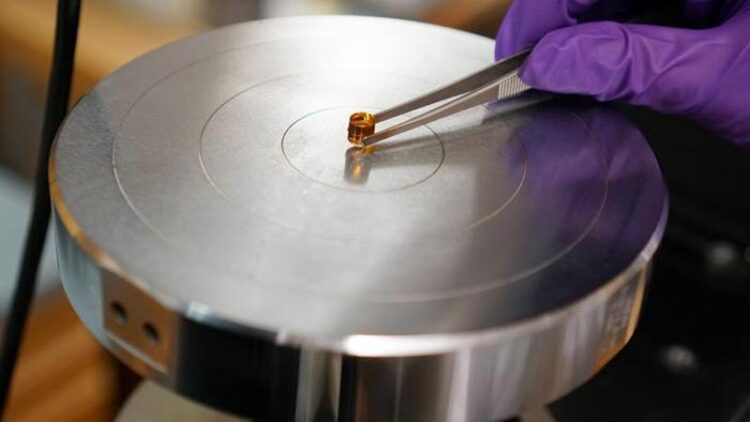Biodegradable gel shows promise for cartilage regeneration

Placing the hydrogel on a compression machine
Credit: Alex Walls
A gel that combines both stiffness and toughness is a step forward in the bid to create biodegradable implants for joint injuries, according to new UBC research.
Mimicking articular cartilage, found in our knee and hip joints, is challenging. This cartilage is key to smooth joint movement, and damage to it can cause pain, reduce function, and lead to arthritis. One potential solution is to implant artificial scaffolds made of proteins that help the cartilage regenerate itself as the scaffold biodegrades. How well the cartilage regenerates is linked to how well a scaffold can mimic the biological properties of cartilage, and to date, researchers have struggled to combine the seemingly incompatible properties of stiffness and toughness.
Now, new research by Canadian and Chinese scientists published today in Nature outlines a method to marry these properties in a biodegradable gel. “Cartilage is tricky,” says senior author Dr. Hongbin Li, a professor in the UBC department of chemistry. “Articular cartilage repair represents an important medical challenge because naturally speaking, it doesn’t repair itself.
Biodegradable cartilage implants must strike a delicate balance in that they need to be both stiff and tough, like actual cartilage. Mechanically, when something is stiff, it resists being bent or deformed, but that usually means it’s brittle – when you bend it, it breaks, like glass. When something is tough, it resists breaking, even when you bend it, but it might be too soft to be useful in a joint, like jelly, or even just softer than actual cartilage. That’s the case with current implants that are made from proteins, which creates a mismatch between what the cells need and what’s being provided, says Dr. Li. This leads to the cartilage not repairing as well as it could.
In the study, Dr. Li and his team developed a new approach to stiffen a protein gel without sacrificing toughness, by physically tangling together the chains of a particular protein that made up the gel’s network. “These entangled chains can move, which allows energy, for instance, the impact from jumping, to be dissipated, just like shock absorbers in bikes. In addition, we combined this with an existing method of folding and unfolding proteins, which also allows for energy dissipation,” says first author Dr. Linglan Fu, who conducted the research as a doctoral student at UBC’s department of chemistry.
The resulting gel was super tough, able to resist slicing with a scalpel, and was more stiff than other protein hydrogels. Its ability to resist compression was among the highest achieved by any such gels and compared favorably with actual articular cartilage. And the gel was able to rapidly recover its original shape after compression, as real cartilage does after jumping.
Rabbits implanted with the gel showed notable signs of repair of articular cartilage 12 weeks after implantation, with no hydrogel remaining and no rejection of the implant by the animals’ immune system. The researchers observed bone tissue growth similar to the existing tissue, and regenerated tissue close to existing cartilage for the gel implant group—much better results than they saw with a control group.
Interestingly, a stiffer version of the gel had better results than a softer version, likely due to the higher stiffness being more compatible with bone and cartilage tissues, and so providing a physical cue to the body for effective regeneration. However, there can be such a thing as too stiff: the stiffest gel did not work as well, likely due to its slower degradation in the body, the researchers said. “This just shows how complex this area of research is, and the need to take into account the many different physical and biochemical cues and factors when designing these scaffolds,” says co-author Dr. Qing Jiang, a professor and surgeon at Nanjing University.
Further animal testing is needed and the research is still premature for human trials. The researchers’ next steps include this testing, fine-tuning the current gel composition and adding additional biochemical cues to further promote cell regeneration. “By optimizing both biochemical and biomechanical cues together, we will see in the future whether these new scaffolds can lead to even better outcomes,” Dr. Li says.
DOI: 10.1038/s41586-023-06037-0
Media Contact
Alex Walls
University of British Columbia
alex.walls@ubc.ca
Cell: 7789846173
All latest news from the category: Life Sciences and Chemistry
Articles and reports from the Life Sciences and chemistry area deal with applied and basic research into modern biology, chemistry and human medicine.
Valuable information can be found on a range of life sciences fields including bacteriology, biochemistry, bionics, bioinformatics, biophysics, biotechnology, genetics, geobotany, human biology, marine biology, microbiology, molecular biology, cellular biology, zoology, bioinorganic chemistry, microchemistry and environmental chemistry.
Newest articles

A ‘language’ for ML models to predict nanopore properties
A large number of 2D materials like graphene can have nanopores – small holes formed by missing atoms through which foreign substances can pass. The properties of these nanopores dictate many…

Clinically validated, wearable ultrasound patch
… for continuous blood pressure monitoring. A team of researchers at the University of California San Diego has developed a new and improved wearable ultrasound patch for continuous and noninvasive…

A new puzzle piece for string theory research
Dr. Ksenia Fedosova from the Cluster of Excellence Mathematics Münster, along with an international research team, has proven a conjecture in string theory that physicists had proposed regarding certain equations….



